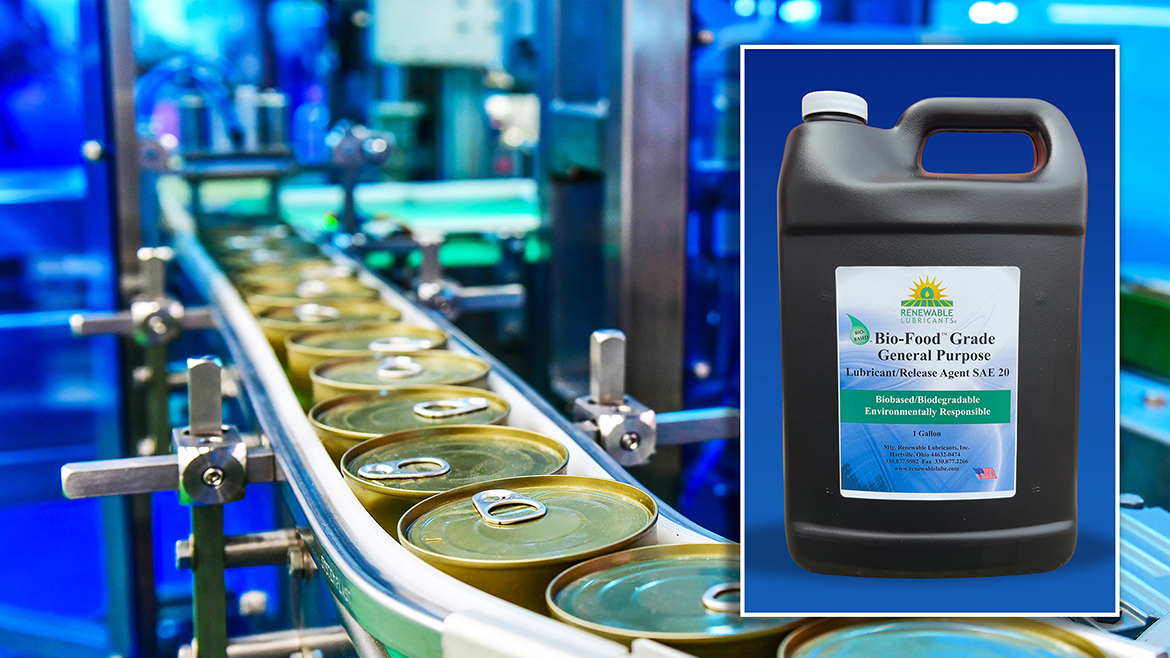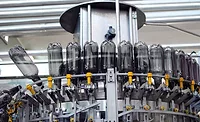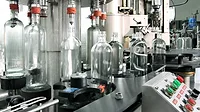Food grade lubricants protect products, deliver on sustainability
Synthetic, bio-based solutions both in demand for beverage manufacturing

The phrase “better safe than sorry” might get tossed around by parents reminding their kids to grab a jacket and other day-to-day tasks, but it takes on more serious implications when it comes to the safety of food and beverage products throughout processing and packaging. To keep products and consumers safe, food grade lubricant advancements are helping beverage-makers meet that goal.
“There has been outstanding growth in the demand for food-grade lubricants,” says Ellie Girard, regional manager at Lubriplate Lubricants Co., Newark, N.J. “The goal in any type of food, beverage or pharmaceutical facility is always to protect the consumer. To do that, the regulatory landscape is constantly changing across the entire supply chain, which lubricants are obviously a part of. The advent of the ISO 21469 standard for lubricants and the Food Safety Modernization Act are examples of some of the regulatory changes that have caused major growth in the demand for food-grade lubricants.”
Girard notes that these regulations have prompted interest in facilities becoming 100% food grade lubrication compliant.
“Food safety measures have caused a shift in facilities to now being more open to converting to a 100% food-grade lubrication program,” Girard says. “In the past, there had been some pause to make the shift away from traditional industrial products due to fears of lack luster performance, availability of products, etc. However, the technology behind food-grade lubricants, specifically synthetic, food-grade oils and greases, has proven time and time again that these types of products perform just as well, if not better than those industrial products.”
Benjamin Garmier, vice president at Renewable Lubricants Inc., Hartville, Ohio, also notes the growth of the food grade lubricant market and its correlation to regulations and consumers’ consciousness of food safety.
“This growth can be largely attributed to increasing governmental regulations and the more rigorous enforcement and oversight of these standards,” Garmier says. “As awareness of food safety and contamination risks continues to rise, regulatory bodies like the FDA, USDA, and equivalent organizations globally have implemented stricter guidelines for food processing facilities. These guidelines require the use of lubricants that meet food-grade standards, which ensure that incidental contact with food products does not pose health risks.
“Moreover, consumers today are more conscious of food safety and the sustainability of production processes, which has put pressure on manufacturers to adopt safer, environmentally acceptable practices,” he continues. “This demand for transparency has led to a shift toward lubricants that not only meet food-grade requirements but also align with broader sustainability goals.”
Balancing sustainability
Like many aspects within the beverage manufacturing market, sustainability continues to play a role in interest in food grade lubricants.
Karla Ruiz, national account manager of the global industry team for the U.S. and Canada at Klüber Lubrication NA LP, Londonderry, N.H., also points to the influence of sustainability.
“There is a growing trend toward sustainable and environmentally friendly practices in food production, leading to a preference for biodegradable and non-toxic lubricants,” she says.
Ruiz points to energy efficiency and environmental impact as some of the sustainable reasonings for the interest in bio-based lubricants.

“Sustainable lubricants are often designed to improve energy efficiency in machinery, this includes formulations that reduce friction and wear, leading to lower energy consumption and greenhouse gas emissions,” she says. “… There is a growing demand for bio-based lubricants made from renewable resources, such as vegetable oils. These lubricants are often biodegradable and have a reduced environmental impact compared to traditional petroleum-based products.”
The implementation of sustainability initiatives by corporations, including carbon footprint reduction, minimizing waste, and using more environmentally friendly products also have prompted usage of food grade lubricants, Renewable Lubricants’ Garmier says.
“These initiatives often include a preference for bio-based and biodegradable lubricants that align with their goals of reducing environmental impact,” he explains.
However, despite this interest, Garmier adds that Renewable Lubricants still has not seen this have a significant impact on its sales.
“This could be due to various factors, such as the pace at which companies transition from traditional petroleum-based lubricants to sustainable options,” he says. “Although some organizations are prioritizing sustainability, the switch often involves thorough testing, validation, and certification processes, which can delay widespread adoption. Additionally, the higher initial cost of sustainable lubricants can be a barrier, especially when companies weigh upfront costs against long-term environmental benefits.”
Meanwhile, Lubriplate Lubricants’ Girard notes that sustainability must also support performance goals.
“In terms of sustainability and lubricants, I think most facilities are looking for lubricants that will last longer without sacrificing performance of the oil or grease,” she says. “This is where synthetic products come into play. In addition to providing a longer lubricant life, a lot of synthetic products will fall somewhere on the biodegradability scale, making them environmentally friendly.”
Beverages’ impact on lubricants
Although macro trends might have an impact on the lubricants’ market, expert note that the beverage market also is impacting the demand and needs for lubricants.
Klüber Lubrication’s Ruiz calls attention to the growth of the beverage market. “The expansion of [the] beverage industry increases the need for effective lubrication solutions that comply with safety standards,” she says.
The rise of a globalized market also has prompted interest in food grade lubricants. “As U.S. beverage products are exported more widely, compliance with international food safety standards necessitate the use of FG lubricants,” Ruiz explains.
Noting how rapidly the beverage industry evolves, Ruiz identifies a host of trends influencing lubricants, including health and wellness.
“This trend impacts lubricant formulations, as manufacturers may require lubricants that can handle new types of production processes and ingredients, including those that are less viscous or have different chemical properties,” she says.
Eco-friendly products as well as craft and artisanal beverages also has prompted the need for specialized equipment, tailoring lubricant options, she notes.
Automation and packaging innovations also are influencing lubricants.
…There is a growing demand for bio-based lubricants made from renewable resources, such as vegetable oils. These lubricants are often biodegradable and have a reduced environmental impact compared to traditional petroleum-based products.
“The increased use of automation and advanced technology in beverage production necessitates high-performance lubricants that withstand the demand of automated systems,” Ruiz says. “This includes lubricants that provide better lubrication under varying temperatures and pressures.
“… The trend toward innovative packaging solutions, such as lightweight materials or recyclable options, can affect the types of lubricants needed during the packing process,” she continues. “Lubricants must be compatible with new materials and processes to ensure efficient production.”
Renewable Lubricants’ Garmier further highlights beverage manufacturers interest in getting away from lubricants that could cause concern if they came in contact with food or beverage products.
“A key trend in the beverage industry is the shift toward PTFE (Teflon), petroleum, and silicone-free lubricants,” he says. “Over the past year, manufacturers have focused on removing these substances to comply with stricter safety standards and meet demand for cleaner production practices.
“The move is driven by concerns about contamination risks,” Garmier continues. “While PTFE, petroleum, and silicone have useful properties, they can pose safety concerns if they come into contact with food. As a result, manufacturers are turning to safer alternatives, like boron nitride, known as ‘white graphite,’ which offers effective lubrication without the risks associated with PTFE.”
Garmier anticipates that this interest is likely to continue and will gain traction in the years to come.
“In the next 10 years, the demand for safer alternatives to petroleum-based food-grade products will continue to rise,” Garmier says. “As sustainability becomes an even greater priority, customers will increasingly seek to ‘close the loop’ on food-grade lubricants, meaning they’ll focus on options that are not only safe but also recyclable or biodegradable, contributing to a circular economy.
“This shift will drive interest in renewable carbon alternatives to traditional petroleum-based lubricants,” he continues. “Bio-based and re-refined options, which use renewable sources and minimize waste, will likely become the standard as manufacturers strive to reduce their environmental footprint. This focus on sustainability will push the development of lubricants that not only meet strict food safety requirements but also align with the industry’s broader environmental goals, offering performance without compromise.”
Other experts still see synthetic, food-grade lubricants as playing a valuable role in beverage manufacturing, given its host of benefits.
“I believe that the demand for synthetic, food-grade lubricants will continue to grow,” Lubriplate Lubricants’ Girard says. “These products offer incredible benefits to maintain the health of plant machinery and many facilities are recognizing this and making the switch over.”
As product safety remains paramount, it suggests that the demand and interest in food grade lubricants will continue to grow.
Looking for a reprint of this article?
From high-res PDFs to custom plaques, order your copy today!









